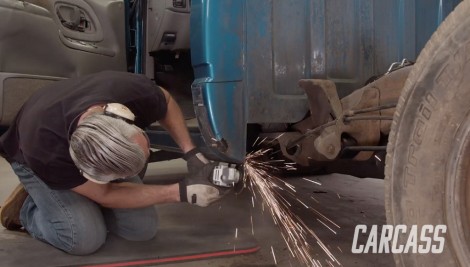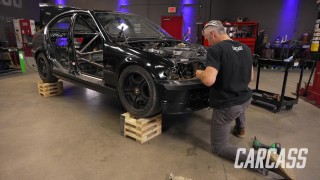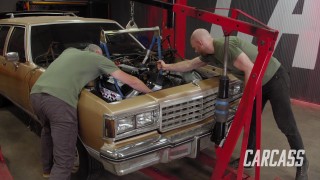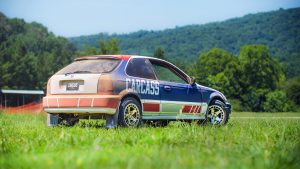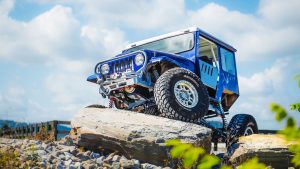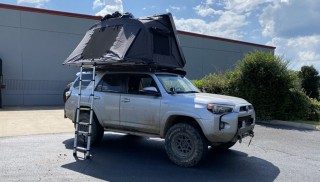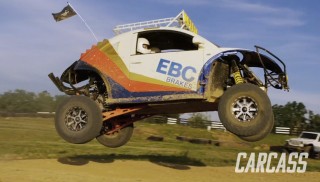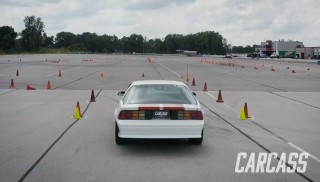Carcass Featured Projects
Carcass Builds
Want more content like this?
Join the PowerNation Email NewsletterParts Used In This Episode
Matco Tools
Pneumatic Hole Punch
Matco Tools
Starter Plus Stud Welder
The Industrial Depot
Tools, Hardware, Shop Supplies
Video Transcript
(Jeremy)>> You're watching Powernation!
(Jeremy)>> Today on Carcass we have an abandoned project that's a little rough around the edges and we want to turn it into a daily driver.
(Jimmy)>> We'll show you how to repair rust in the common trouble areas. Plus give you several tips on how to straighten out minor body damage. [ MUSIC ]
(Jimmy)>> What's up everyone, welcome to Carcass. Today we have an o-b-s Chevy in the shop, and although we did build one last season this is for a very different purpose. This truck has a ton of miles. It has dents and dings. It has rust in a few places, and we want to use it as a platform to show you guys how you can fix something like this and bring it back in better condition.
(Jeremy)>> It really doesn't matter if it's a Ford, a Chevy, or a Dodge, or if it's a car or a truck. Jimmy said we're gonna use this as a platform to kinda show you guys how to straighten out your vehicle and do a little bit of body work. So, we're gonna be pulling out a couple of dents and dings. We're also gonna be doing some rust repair, and this truck has the one spot where they most commonly like to rust, and that's right down here at the cab corner. Now the plus side to this being the most common spot that the trucks rust out is that they make a repair panel to fix pretty much every make and model, and with the cost of these repair panels it really doesn't make any sense to try to fix this little hole down here. We're just gonna go ahead and replace the entire cab corner, and the easiest way to get to that cab corner is we've just got to get rid of the box first. [ drill humming ]
(Jimmy)>> And if you don't have a cherry picker handy to get the bed off just ask a couple of friends. It's easy to take off. [ MUSIC ]
(Jeremy)>> Like we've shown you before, we'll use a heat gun to apply a little bit of heat to the molding, and then use a scraper to peel it right off. [ heat gun humming ]
(Jeremy)>> Alright, now that we have the bed off, we can have a really good look at how much rust is down here in the cab corner. So that thing's pretty much shot. We picked up this replacement cab corner from Summit Racing, and the idea here is to only use what we need. So, we're gonna come and cut this right at the body line. The reason why we're doing it at the body line is when we go back to weld this together, we're gonna be adding a lot of heat to this thin sheet metal. Heat equals warpage, and that equals more body work, but when you do some of your welding on a body line it stays a little bit stronger, less warpage, less body work. So, the idea here is we'll come across, cut this right here on the body line, get this all peeled off, and we'll get the new one put right back on. [ MUSIC ] [ saw buzzing ]
(Jeremy)>> When cutting off body panels make sure to keep your cutting disc really shallow because you never know what's behind the panel, and you don't want to cut or damage anything else. [ saw buzzing ] [ MUSIC ]
(Jeremy)>> Alright, we have the cab corner off. As you guys can see there's a little bit of rust damage down here inside. We're not too concerned about that, but we will take care of it a little later. What I have to do yet is actually center punch all of the spot welds over here on the pinch weld areas, and then we'll have to just drill those out as well. We'll just keep moving right along here. [ MUSIC ] [ drill humming ]
(Jeremy)>> Tab out of there, that works! [ MUSIC ] Alright guys let's talk about the rust that's down here inside the cab area. Now there's two ways to go about fixing this. If you guys are gonna restore the truck, what you could do is cut all of this out, but you probably would have to make your own repair panels cause they don't make any patch panels for this, or you could do what we're gonna do, and that's just mainly stop or slow down new rust from forming. So, what we're gonna do is grab the wire wheel here. we'll clean all of this up, and then we're gonna spray it with some rust fix. We'll let that dry. From there we'll go on to test fitting the cab corner. [ grinder buzzing ]
(Jeremy)>> Okay, now that we have the rust all cleaned up, we're gonna go ahead and spray this with some rust fix. I know this kinda looks like it is rust. It's not! It's actually some sound deadening that they spray from the factory. So, we'll go ahead and spray everything down here. we'll give it a couple of coats, and then we'll move on to installing the cab corner. [ aerosol can hissing ] Alright, well now that we have the inside all taken care of, we can cut the new cab corner to fit. There's two ways you guys can do this. You can actually take the old piece that you cut out, lay it on top of your cab corner, trace and cut it out, or what we did is we cut right here on the body line. So, all I'm going to do is take the body line of the new cab corner. We'll come up about an eighth or a quarter of an inch, and we'll make our cut line there. That way as I test fit it onto the truck I can sneak up to our original cut line. Then we can get it to fit perfectly. So, I'll head over to the bench. We'll cut this down to fit. Then we'll get this thing welded on the truck. With our patch panels cut out we'll show you how to make it fit like new.
(Jeremy)>> Alright guys, we have the old cab corner out and the new cab corner is fitting very nicely. Now to get this prepped and ready for installation we're gonna have to punch a series of holes in these two flanges here. We'll have to come back and take the e-coating off of the panel, and we'll have to take the paint off of the truck. Then we'll fire up the welder and get this puppy installed. Yeah, that fits really nice. To punch our holes we're using our pneumatic Matco Tools hole punch. It makes short work of projects like this. Then we'll start prepping the body by removing the paint so we can get ready to weld. [ grinder buzzing ]
(Jeremy)>> Alright guys, so the panel's in, test fit's done, and it's all prepped and ready to weld. A couple of things you're gonna want. One, your welder, you're gonna want a low amperage. We're not looking for any type of structural welding here. We're just trying to hold two pieces of steel together, and two and most importantly, you want a little tiny screwdriver. What you can do with this is actually get it up in between the two pieces of metal and shift it around. The closer you can get these parts to fit the less body work you have to do. So that's what we're shooting for. It fits pretty good. So, we'll go ahead and throw the helmet on and put a couple of tacks in place. We'll start off with some nice small tacks, and then we can always come back and adjust the welder from there. [ welder crackling ]
(Jeremy)>> Once we've got it tacked in we'll start filling in between each one of the welds. So, we're gonna start stitching it together. We'll do short pulls of the trigger creating a stitch weld. That way we don't drive a lot of heat into the panel causing it to warp. So just take your time and move all the way around the panel. [ welder crackling ]
(Jeremy)>> From there we'll fill in the holes with some rosette welds. Alright well we're all welded up and it's time to move on to a very crucial step and that's grinding. What we've done is stacked up two cut off wheels. So, it gives us a little more thickness, and we're gonna lay the grinder across the weld like this. Now as we grind we're gonna pay attention to either when we touch the top or the bottom part of our metal, and then we're gonna stop or we're gonna move on quickly. What we don't' want to do is take too much material away and chance this cracking down the road. So, we're just gonna barely brush across the top and knock all that down, and then we're gonna come across it with a flap disc and smooth out the line that we just welded up. A smooth line means less body work, and that means you get the job done a whole lot quicker. [ MUSIC ] That should do that just fine. Alright, well we're all done grinding and it actually turned out pretty straight, but we are gonna add a little bit of body filler. Now what I like to do is put some deep scratches into the steel here, and what that does is it helps the filler really bite and attach to the metal. So, you can use sandpaper. Anything from 36 to 80 grit. So, we'll go ahead, sand this down a little bit, and we'll mix up some mud and get it on the truck. [ scratching ] [ MUSIC ]
(Jeremy)>> Mix this until it's consistently kind of a grayish blue. Get everything nicely so it sets up evenly when you put it on the truck. [ MUSIC ] With our body filler setup it's time to start standing. Now we're gonna do this in a couple of stages. We're gonna start with 80 grit and we're slowly gonna work our way all the way up to 320 grit, and we're gonna try to make this as smooth as possible. From there shoot a little bit of primer on it and it's ready for some paint. We also have a couple more things that we do want to do. We've got some dents and dings on the hood that we want to take care of, but for now I'm gonna get this thing sanded and get it close to being ready for some primer.
(Jeremy)>> Coming up, pesky dent repair that doesn't damage your paint.
(Jimmy)>> Jeremy made some great progress on the cab corner of our Chevy 1,500 pickup. It's all smoothed out and ready for paint, but there's some more damage on the hood that we want to take care of.
(Jeremy)>> There's actually three different types of dents on the hood, and this one up here has got a little bit of a crease to it. This dent right here actually has some paint damage to it, but there's a dent over here that's kind of the run of the mill dent. It doesn't have any paint damage at all. So, we're gonna do some p-d-r, or paintless dent repair, to this one, and Jimmy actually has a pretty cool tool that's gonna help us take care of this.
(Jimmy)>> Like Jeremy said, we're doing a paintless dent repair, which is a great option if you can do it because it's gonna save you a lot of time and money in the long run not having to prep a panel and eventually go and paint it. This dent fix kit that we got from Matco Tools includes everything that we need to that on our green truck, including hot glue gun, glue sticks, a large variety of pulling nibs, a squeeze puller, slide hammer, and some shaping tools to give us a lot of options for whatever we are working on, and to show you how this thing works we'll head over to the truck and get started. [ MUSIC ] Alright so the idea here is you don't want to press it down against the panel. You want to leave about an eighth inch of glue between the nib and the panel. So, we just kinda have to let this setup up, and then we'll start pulling on it. [ MUSIC ] Another thing with this is you don't want to just jamb on the handle cause you might pull the nib out, or you might overdue pulling the dent out. So, you just want to kinda watch it very carefully. Just kind of massage it. [ MUSIC ] Alright so I think we got quite a bit of the dent out. So, I'm gonna take this off and just check it and see where we're at. To get the glue to release we'll just spray it with some of this release spray, and then use a scraper to get it off. Yeah, it's really easy. So, I've got the majority of this dent pulled out, but I think I'm gonna go back and do a little bit more massaging to get it looking a little bit better, but the beauty of this system is that the paint in this area hasn't been disturbed at all. So once you get the desired result there's no finishing work really to be done. Of course this truck has a lot of other issues, and on the other side of the hood there's some dents and creases that have the paint chipped off already. So, Jeremy's gonna show you how to fix those using one more method.
(Jeremy)>> Now to take care of the dents on the other side of the hood we're gonna have to do something a little more aggressive and use a tool called a stud gun, and that involves removing some paint. It's kinda close to what Jimmy was doing but it's just a little bit different. Jimmy how did this turn out?
(Jimmy)>> It came out really good. I'm very impressed with how none of the paint got damaged whatsoever. So, I'm curious how your side's gonna come out.
(Jeremy)>> Yeah, this dent's a little bit different. We'll take a really good look at this first before we dive into it. Alright so let's take a really good look at this dent right here. There's actually a crease, or there's two creases in it, and that's why we can't use the glue gun to pull this out. It's just gonna take entirely too much force to reverse this dent, but before we get in here and start grinding paint to put some of the studs on to do the pull, we're gonna take a really good look on the back side cause we might be able to push on that dent from the back and get it out just a little bit. There's actually a little access hole back, like a manufacturing hole that they have, and I can feel the dent. It's kinda right at the very edge of it. So, I'm gonna grab some tools and we'll see if we can't push this out just a little bit. I don't think we'll get the whole thing out, but we might be able to help it so I don't have to do as much work with the stud gun. So, I'll go grab some tools here quick and we'll see what we can do. Alright, first thing to do before you get started is to give yourself plenty of light. Then we're gonna take these little picks here. We're actually gonna get up and start tapping on the bottom side of the crease. We're gonna do that really lightly and slowly move that dent up. And then when we're done, we'll go ahead, grab the stud gun, and finish this whole thing off. [ hammer tapping ]
(Jeremy)>> The big thing is as you're doing it too don't be afraid to check and see how it's going. [ tapping metal ]
(Jeremy)>> That's pretty close. That's probably as close as we're gonna get it using this type of method I guess, and from here we use the stud gun cause there's a lull on this side. We've still got a little high in the center, and then a lull on this side. So, what I'll end up doing is taking some of the paint off, and then we're gonna use the stud gun. We'll pull the lows back up. We'll tap the high down and see how we look. [ grinder buzzing ]
(Jeremy)>> Alright, now we're all ready to weld the studs on. We're going to be using a Matco Tool stud gun. What that does is it welds these little copper studs onto the bare metal. So, you just set it on to the spot where you like it, or where you want it to be, push it down, pull the trigger. What that does is that welds that stud onto the low spot. Now what we'll do is we'll weld a series of these studs onto this panel in a couple of different areas. Then we'll come back, make a couple of pulls, see how straight we can get this thing. Don't go away. We finish showing you how to straighten out minor body damage on your daily driver.
(Jeremy)>> Alright guys, well we've been removing some dents on the hood, and Jimmy took care of the one on the passenger side using the paintless dent removal process, and I've been tackling the one on the driver's side that had a bit of a crease in it. Now we did a little bit of work from the back side using a hammer and a little pick to try to drive it out, but we couldn't quite get it perfect. So, we welded a couple of studs on it, and now we're gonna finish it off doing a little pull. We're gonna be using a couple of different tools for that. This little T-handle here, and if that doesn't work we're gonna move on to the slide hammer, but first we'll try the T-handle and see if I can't just pull it out. Just to kinda bite on there. Try to do some pulls. Now it is moving, but I don't know if it's staying there. We're not going for perfection here. We know we have to put a little bit of mud on it, but I think from here we'll check it with a straight edge, and then if we have to give it a little tap with the slide hammer, we can do that too. Check it with a straight edge. It's just a little low yet. It's probably good enough to put a little bit of mud on it, body filler. We'll give it a couple of taps with the slide hammer, bring it up. Now for the slide hammer it's basically the same except we're just gonna kinda use it to jar the panel up, or the dent, I guess. [ metal banging ] [ MUSIC ]
(Jeremy)>> Now we've got maybe a sixteenth of an inch here. So, we'll call that. We know we're gonna have to do a little bit of body filler work. We'll snip off the studs with a side cutter, and then grind them flat. Alright so this dent is pretty straight, and it feels pretty good, and it's ready for some body filler work, but we do have a couple of more dents up here on the hood, and those are gonna be basically rinse and repeat to what we did up front here. So, I'm gonna go ahead and take care of these quick. Then we can prep these so we can put body filler on both spots at the same time and just tackle it like that. Alright, we'll we're all prepped and ready to put down some filler, and you guys are probably wondering why I have such a large area prepped around the two small dents that we took care of. There is a reason for that. As you start laying out your filler, you're naturally gonna make the area a little bit bigger and bigger with the coverage of your filler. So that's why you always just make it a little bit bigger. Don't worry, you're gonna end up sanding most of it off anyways just to get most of these two dents straight. So, we're gonna go ahead and mix some of this filler up. I'll go ahead and put it on the top and the front here, and then we'll sand it, and then I'm gonna show you guys a cool little trick on how to mask so you don't get a hard edge when you go to prime. [ MUSIC ] Just like on the cab corner we'll start with 80 grit and then work our way up to 320. [ scratching ] [ compressed air hissing ]
(Jeremy)>> Alright, that's pretty smooth. It's ready for some paper, and then you can go ahead and prime it too.
(Jimmy)>> Sounds good. Alright so normally when you would tape this off intuitively you would probably tape it like this and just make a border around where you don't want paint but having the tape right on the surface makes a really hard edge. So, what we're actually gonna do is turn the paper around. We'll lay the paper down, and then we will fold the paper back over itself, and the paper's gonna create a round edge. So, when you go to paint the paint will kinda loft in, and then it makes it easier to blend that when you start sanding. [ MUSIC ]
(Jeremy)>> That looks really good actually.
(Jimmy)>> You did a nice job on the body work. So just a couple more coats here and then we'll get it cleaned up.
(Jeremy)>> That's the joys of using spray paint, right?
(Jimmy)>> If you like anything you've seen be sure to check Powernation TV.
Show Full Transcript
(Jeremy)>> Today on Carcass we have an abandoned project that's a little rough around the edges and we want to turn it into a daily driver.
(Jimmy)>> We'll show you how to repair rust in the common trouble areas. Plus give you several tips on how to straighten out minor body damage. [ MUSIC ]
(Jimmy)>> What's up everyone, welcome to Carcass. Today we have an o-b-s Chevy in the shop, and although we did build one last season this is for a very different purpose. This truck has a ton of miles. It has dents and dings. It has rust in a few places, and we want to use it as a platform to show you guys how you can fix something like this and bring it back in better condition.
(Jeremy)>> It really doesn't matter if it's a Ford, a Chevy, or a Dodge, or if it's a car or a truck. Jimmy said we're gonna use this as a platform to kinda show you guys how to straighten out your vehicle and do a little bit of body work. So, we're gonna be pulling out a couple of dents and dings. We're also gonna be doing some rust repair, and this truck has the one spot where they most commonly like to rust, and that's right down here at the cab corner. Now the plus side to this being the most common spot that the trucks rust out is that they make a repair panel to fix pretty much every make and model, and with the cost of these repair panels it really doesn't make any sense to try to fix this little hole down here. We're just gonna go ahead and replace the entire cab corner, and the easiest way to get to that cab corner is we've just got to get rid of the box first. [ drill humming ]
(Jimmy)>> And if you don't have a cherry picker handy to get the bed off just ask a couple of friends. It's easy to take off. [ MUSIC ]
(Jeremy)>> Like we've shown you before, we'll use a heat gun to apply a little bit of heat to the molding, and then use a scraper to peel it right off. [ heat gun humming ]
(Jeremy)>> Alright, now that we have the bed off, we can have a really good look at how much rust is down here in the cab corner. So that thing's pretty much shot. We picked up this replacement cab corner from Summit Racing, and the idea here is to only use what we need. So, we're gonna come and cut this right at the body line. The reason why we're doing it at the body line is when we go back to weld this together, we're gonna be adding a lot of heat to this thin sheet metal. Heat equals warpage, and that equals more body work, but when you do some of your welding on a body line it stays a little bit stronger, less warpage, less body work. So, the idea here is we'll come across, cut this right here on the body line, get this all peeled off, and we'll get the new one put right back on. [ MUSIC ] [ saw buzzing ]
(Jeremy)>> When cutting off body panels make sure to keep your cutting disc really shallow because you never know what's behind the panel, and you don't want to cut or damage anything else. [ saw buzzing ] [ MUSIC ]
(Jeremy)>> Alright, we have the cab corner off. As you guys can see there's a little bit of rust damage down here inside. We're not too concerned about that, but we will take care of it a little later. What I have to do yet is actually center punch all of the spot welds over here on the pinch weld areas, and then we'll have to just drill those out as well. We'll just keep moving right along here. [ MUSIC ] [ drill humming ]
(Jeremy)>> Tab out of there, that works! [ MUSIC ] Alright guys let's talk about the rust that's down here inside the cab area. Now there's two ways to go about fixing this. If you guys are gonna restore the truck, what you could do is cut all of this out, but you probably would have to make your own repair panels cause they don't make any patch panels for this, or you could do what we're gonna do, and that's just mainly stop or slow down new rust from forming. So, what we're gonna do is grab the wire wheel here. we'll clean all of this up, and then we're gonna spray it with some rust fix. We'll let that dry. From there we'll go on to test fitting the cab corner. [ grinder buzzing ]
(Jeremy)>> Okay, now that we have the rust all cleaned up, we're gonna go ahead and spray this with some rust fix. I know this kinda looks like it is rust. It's not! It's actually some sound deadening that they spray from the factory. So, we'll go ahead and spray everything down here. we'll give it a couple of coats, and then we'll move on to installing the cab corner. [ aerosol can hissing ] Alright, well now that we have the inside all taken care of, we can cut the new cab corner to fit. There's two ways you guys can do this. You can actually take the old piece that you cut out, lay it on top of your cab corner, trace and cut it out, or what we did is we cut right here on the body line. So, all I'm going to do is take the body line of the new cab corner. We'll come up about an eighth or a quarter of an inch, and we'll make our cut line there. That way as I test fit it onto the truck I can sneak up to our original cut line. Then we can get it to fit perfectly. So, I'll head over to the bench. We'll cut this down to fit. Then we'll get this thing welded on the truck. With our patch panels cut out we'll show you how to make it fit like new.
(Jeremy)>> Alright guys, we have the old cab corner out and the new cab corner is fitting very nicely. Now to get this prepped and ready for installation we're gonna have to punch a series of holes in these two flanges here. We'll have to come back and take the e-coating off of the panel, and we'll have to take the paint off of the truck. Then we'll fire up the welder and get this puppy installed. Yeah, that fits really nice. To punch our holes we're using our pneumatic Matco Tools hole punch. It makes short work of projects like this. Then we'll start prepping the body by removing the paint so we can get ready to weld. [ grinder buzzing ]
(Jeremy)>> Alright guys, so the panel's in, test fit's done, and it's all prepped and ready to weld. A couple of things you're gonna want. One, your welder, you're gonna want a low amperage. We're not looking for any type of structural welding here. We're just trying to hold two pieces of steel together, and two and most importantly, you want a little tiny screwdriver. What you can do with this is actually get it up in between the two pieces of metal and shift it around. The closer you can get these parts to fit the less body work you have to do. So that's what we're shooting for. It fits pretty good. So, we'll go ahead and throw the helmet on and put a couple of tacks in place. We'll start off with some nice small tacks, and then we can always come back and adjust the welder from there. [ welder crackling ]
(Jeremy)>> Once we've got it tacked in we'll start filling in between each one of the welds. So, we're gonna start stitching it together. We'll do short pulls of the trigger creating a stitch weld. That way we don't drive a lot of heat into the panel causing it to warp. So just take your time and move all the way around the panel. [ welder crackling ]
(Jeremy)>> From there we'll fill in the holes with some rosette welds. Alright well we're all welded up and it's time to move on to a very crucial step and that's grinding. What we've done is stacked up two cut off wheels. So, it gives us a little more thickness, and we're gonna lay the grinder across the weld like this. Now as we grind we're gonna pay attention to either when we touch the top or the bottom part of our metal, and then we're gonna stop or we're gonna move on quickly. What we don't' want to do is take too much material away and chance this cracking down the road. So, we're just gonna barely brush across the top and knock all that down, and then we're gonna come across it with a flap disc and smooth out the line that we just welded up. A smooth line means less body work, and that means you get the job done a whole lot quicker. [ MUSIC ] That should do that just fine. Alright, well we're all done grinding and it actually turned out pretty straight, but we are gonna add a little bit of body filler. Now what I like to do is put some deep scratches into the steel here, and what that does is it helps the filler really bite and attach to the metal. So, you can use sandpaper. Anything from 36 to 80 grit. So, we'll go ahead, sand this down a little bit, and we'll mix up some mud and get it on the truck. [ scratching ] [ MUSIC ]
(Jeremy)>> Mix this until it's consistently kind of a grayish blue. Get everything nicely so it sets up evenly when you put it on the truck. [ MUSIC ] With our body filler setup it's time to start standing. Now we're gonna do this in a couple of stages. We're gonna start with 80 grit and we're slowly gonna work our way all the way up to 320 grit, and we're gonna try to make this as smooth as possible. From there shoot a little bit of primer on it and it's ready for some paint. We also have a couple more things that we do want to do. We've got some dents and dings on the hood that we want to take care of, but for now I'm gonna get this thing sanded and get it close to being ready for some primer.
(Jeremy)>> Coming up, pesky dent repair that doesn't damage your paint.
(Jimmy)>> Jeremy made some great progress on the cab corner of our Chevy 1,500 pickup. It's all smoothed out and ready for paint, but there's some more damage on the hood that we want to take care of.
(Jeremy)>> There's actually three different types of dents on the hood, and this one up here has got a little bit of a crease to it. This dent right here actually has some paint damage to it, but there's a dent over here that's kind of the run of the mill dent. It doesn't have any paint damage at all. So, we're gonna do some p-d-r, or paintless dent repair, to this one, and Jimmy actually has a pretty cool tool that's gonna help us take care of this.
(Jimmy)>> Like Jeremy said, we're doing a paintless dent repair, which is a great option if you can do it because it's gonna save you a lot of time and money in the long run not having to prep a panel and eventually go and paint it. This dent fix kit that we got from Matco Tools includes everything that we need to that on our green truck, including hot glue gun, glue sticks, a large variety of pulling nibs, a squeeze puller, slide hammer, and some shaping tools to give us a lot of options for whatever we are working on, and to show you how this thing works we'll head over to the truck and get started. [ MUSIC ] Alright so the idea here is you don't want to press it down against the panel. You want to leave about an eighth inch of glue between the nib and the panel. So, we just kinda have to let this setup up, and then we'll start pulling on it. [ MUSIC ] Another thing with this is you don't want to just jamb on the handle cause you might pull the nib out, or you might overdue pulling the dent out. So, you just want to kinda watch it very carefully. Just kind of massage it. [ MUSIC ] Alright so I think we got quite a bit of the dent out. So, I'm gonna take this off and just check it and see where we're at. To get the glue to release we'll just spray it with some of this release spray, and then use a scraper to get it off. Yeah, it's really easy. So, I've got the majority of this dent pulled out, but I think I'm gonna go back and do a little bit more massaging to get it looking a little bit better, but the beauty of this system is that the paint in this area hasn't been disturbed at all. So once you get the desired result there's no finishing work really to be done. Of course this truck has a lot of other issues, and on the other side of the hood there's some dents and creases that have the paint chipped off already. So, Jeremy's gonna show you how to fix those using one more method.
(Jeremy)>> Now to take care of the dents on the other side of the hood we're gonna have to do something a little more aggressive and use a tool called a stud gun, and that involves removing some paint. It's kinda close to what Jimmy was doing but it's just a little bit different. Jimmy how did this turn out?
(Jimmy)>> It came out really good. I'm very impressed with how none of the paint got damaged whatsoever. So, I'm curious how your side's gonna come out.
(Jeremy)>> Yeah, this dent's a little bit different. We'll take a really good look at this first before we dive into it. Alright so let's take a really good look at this dent right here. There's actually a crease, or there's two creases in it, and that's why we can't use the glue gun to pull this out. It's just gonna take entirely too much force to reverse this dent, but before we get in here and start grinding paint to put some of the studs on to do the pull, we're gonna take a really good look on the back side cause we might be able to push on that dent from the back and get it out just a little bit. There's actually a little access hole back, like a manufacturing hole that they have, and I can feel the dent. It's kinda right at the very edge of it. So, I'm gonna grab some tools and we'll see if we can't push this out just a little bit. I don't think we'll get the whole thing out, but we might be able to help it so I don't have to do as much work with the stud gun. So, I'll go grab some tools here quick and we'll see what we can do. Alright, first thing to do before you get started is to give yourself plenty of light. Then we're gonna take these little picks here. We're actually gonna get up and start tapping on the bottom side of the crease. We're gonna do that really lightly and slowly move that dent up. And then when we're done, we'll go ahead, grab the stud gun, and finish this whole thing off. [ hammer tapping ]
(Jeremy)>> The big thing is as you're doing it too don't be afraid to check and see how it's going. [ tapping metal ]
(Jeremy)>> That's pretty close. That's probably as close as we're gonna get it using this type of method I guess, and from here we use the stud gun cause there's a lull on this side. We've still got a little high in the center, and then a lull on this side. So, what I'll end up doing is taking some of the paint off, and then we're gonna use the stud gun. We'll pull the lows back up. We'll tap the high down and see how we look. [ grinder buzzing ]
(Jeremy)>> Alright, now we're all ready to weld the studs on. We're going to be using a Matco Tool stud gun. What that does is it welds these little copper studs onto the bare metal. So, you just set it on to the spot where you like it, or where you want it to be, push it down, pull the trigger. What that does is that welds that stud onto the low spot. Now what we'll do is we'll weld a series of these studs onto this panel in a couple of different areas. Then we'll come back, make a couple of pulls, see how straight we can get this thing. Don't go away. We finish showing you how to straighten out minor body damage on your daily driver.
(Jeremy)>> Alright guys, well we've been removing some dents on the hood, and Jimmy took care of the one on the passenger side using the paintless dent removal process, and I've been tackling the one on the driver's side that had a bit of a crease in it. Now we did a little bit of work from the back side using a hammer and a little pick to try to drive it out, but we couldn't quite get it perfect. So, we welded a couple of studs on it, and now we're gonna finish it off doing a little pull. We're gonna be using a couple of different tools for that. This little T-handle here, and if that doesn't work we're gonna move on to the slide hammer, but first we'll try the T-handle and see if I can't just pull it out. Just to kinda bite on there. Try to do some pulls. Now it is moving, but I don't know if it's staying there. We're not going for perfection here. We know we have to put a little bit of mud on it, but I think from here we'll check it with a straight edge, and then if we have to give it a little tap with the slide hammer, we can do that too. Check it with a straight edge. It's just a little low yet. It's probably good enough to put a little bit of mud on it, body filler. We'll give it a couple of taps with the slide hammer, bring it up. Now for the slide hammer it's basically the same except we're just gonna kinda use it to jar the panel up, or the dent, I guess. [ metal banging ] [ MUSIC ]
(Jeremy)>> Now we've got maybe a sixteenth of an inch here. So, we'll call that. We know we're gonna have to do a little bit of body filler work. We'll snip off the studs with a side cutter, and then grind them flat. Alright so this dent is pretty straight, and it feels pretty good, and it's ready for some body filler work, but we do have a couple of more dents up here on the hood, and those are gonna be basically rinse and repeat to what we did up front here. So, I'm gonna go ahead and take care of these quick. Then we can prep these so we can put body filler on both spots at the same time and just tackle it like that. Alright, we'll we're all prepped and ready to put down some filler, and you guys are probably wondering why I have such a large area prepped around the two small dents that we took care of. There is a reason for that. As you start laying out your filler, you're naturally gonna make the area a little bit bigger and bigger with the coverage of your filler. So that's why you always just make it a little bit bigger. Don't worry, you're gonna end up sanding most of it off anyways just to get most of these two dents straight. So, we're gonna go ahead and mix some of this filler up. I'll go ahead and put it on the top and the front here, and then we'll sand it, and then I'm gonna show you guys a cool little trick on how to mask so you don't get a hard edge when you go to prime. [ MUSIC ] Just like on the cab corner we'll start with 80 grit and then work our way up to 320. [ scratching ] [ compressed air hissing ]
(Jeremy)>> Alright, that's pretty smooth. It's ready for some paper, and then you can go ahead and prime it too.
(Jimmy)>> Sounds good. Alright so normally when you would tape this off intuitively you would probably tape it like this and just make a border around where you don't want paint but having the tape right on the surface makes a really hard edge. So, what we're actually gonna do is turn the paper around. We'll lay the paper down, and then we will fold the paper back over itself, and the paper's gonna create a round edge. So, when you go to paint the paint will kinda loft in, and then it makes it easier to blend that when you start sanding. [ MUSIC ]
(Jeremy)>> That looks really good actually.
(Jimmy)>> You did a nice job on the body work. So just a couple more coats here and then we'll get it cleaned up.
(Jeremy)>> That's the joys of using spray paint, right?
(Jimmy)>> If you like anything you've seen be sure to check Powernation TV.
